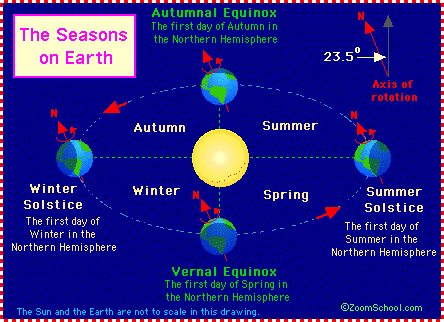

Earth's Tilt 1: The Reason for the Season
https://www.youtube.com/watch?v=Pgq0LThW7QA
The Reason for the Seasons applet http://www.asc-csa.gc.ca/swf/educateurs/ressources/astronomie/eng/multimedia/module3/reasons-seasons/reasons-seasons.swf
The Earth's axis is tilted 23.45°. This tilting is what gives us the four seasons of the year - spring, summer, autumn (fall) and winter. Since the axis is tilted, different parts of the globe are oriented towards the Sun at different times of the year.
Summer is warmer than winter (in each hemisphere) because the Sun's rays hit the Earth at a more direct angle during summer than during winter and also because the days are much longer than the nights during the summer. During the winter, the Sun's rays hit the Earth at an extreme angle, and the days are very short. These effects are due to the tilt of the Earth's axis.
Solstices
The solstices are days when the Sun reaches its farthest northern and southern
angles. The winter solstice occurs on December 21 or 22 and marks the beginning
of winter (this is the shortest day of the year). The summer solstice occurs
on June 21 and marks the beginning of summer (this is the longest day of
the year).
Equinoxes
Equinoxes are days in which day and night are of equal length. The two
yearly equinoxes occur when the Sun crosses the celestial equator.
The vernal equinox occurs in late March (this is the beginning of spring in the Northern Hemisphere and the beginning of fall in the Southern Hemisphere); the autumnal equinox occurs in late September (this is the beginning of fall in the Northern Hemisphere and the beginning of spring in the Southern Hemisphere).